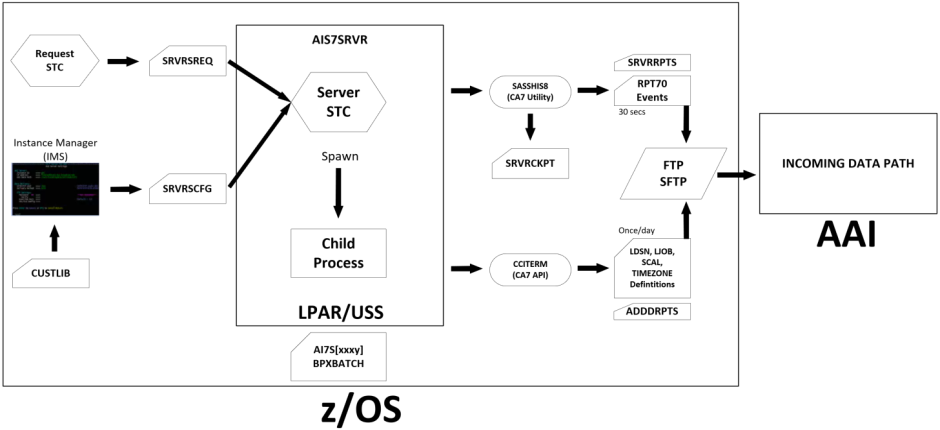Architecture of the CA7 Server for AAI
The CA7 Server for AAI is a Broadcom's software solution that caters for the integration between CA7 and AAI. It is installed on the mainframe to retrieve CA7 job definition data and event data and to pass them onto AAI. This topic explains the components that make up an instance of the CA7 Server for AAI.
The CA7 Server for AAI consists of two STCs and an ISPF-based Instance Management System user interface. This graphic illustrates it:

The following sections explain the graphic:
Server STC
The primary Server STC is a continuously running task that executes in the LPAR/USS environment. It is initially started via an instance- specific JCL that invokes BPXBATCH to start the Unix environment. When the environment is up and running, it executes a Unix module called AI7S[xxxy]. This is the Server STC code executing under the process name of AI7S[xxxy], where xxxy identifies the specific Instance of the CA7 Server for AAI.
The Server STC functions are:
-
Generate and deliver the event data files to the AAI server
With each pull cycle that you define (in the graphic, this is 30 seconds), the Server STC uses the SASSHIS8 utility to generate an intermediate dataset called SRVRRPTS. SRVRRPTS contains the names and timestamps of the events for each pull cycle. Based on SRVRRPTS, an RPT70.YYMMDD.HHmmss file is generated that is sent via FTP/SFTP to the AAI server.
As soon as this file is sent, the SASSHIS8 updates a checkpoint dataset called SRVRCKPT that contains the date and timestamp of the last successfully delivered RPT70. The SRVRCKPT dataset is used for automatic data recovery purposes during a WARM start of the CA7 Server for AAI.
-
Generate and deliver the job definition data to the AAI server
This type of data does not generally change very often (in the graphic, this is once a day). To collect and send this data, the Server STC spawns a child process that uses a CA7 API called CCITERM to generate four datasets with the CA7 job definition data:
-
LDSN for job dependency definitions
-
LJOB for job definitions
-
SCAL for calendar conditions
-
TIMEZONE with the CA7 timezone
These four datasets are created in turn via CCITERM based and stored in the ADDDRPTS intermediate dataset before being sent via FTP/SFTP to the AAI server.
-
Instance Management System (IMS)
The IMS is an interactive menu based on ISPF. You add, configure and control instances of the CA7 Server for AAI from the IMS. The CUSTLIB library contains the configuration files and JCLs that you need to manage an IMS instance. The CUSTLIB library is common to all defined IMS instances.
When you create an IMS instance, a number of JCLs members are generated in the CUSTLIB, one of them being the JCL AIS7[xxxy] . Executing this JCL starts the CA7 Server for AAI primary STC for the specific instance identified by the [xxxy] suffix.
The IMS can support up to 8 instances of the CA7 Server for AAI. This means that you can deploy up to 8 instances of the CA7 Server for AAI on a given LPAR or across multiple LPARs and manage them all through the same IMS instance.
Each CA7 Server for AAI instance has a configuration dataset called SRVRSCFG that stores all its configuration parameters.
You need a separate instance defined in the IMS for each.
Request STC
The Request STC is a transient task primarily used by automation solutions to issue control commands to the Server STC. The Request STC executes in a z/OS Address Space. When an instance of the CA7 Server for AAI is defined, a JCL member called AI7R[XXXY] is created in the CUSTLIB.
This contains the JCL needed to execute the Request STC. The main functions of the Request STC are:
-
Automate the shutdown of the Server STC through the SRVRSREQ library.
-
Initiate other Server STC actions, for example requesting definition data generation and delivery.
Next Steps
Now that you are familiarized with the basic architecture of the CA7 Server for AAI you can start with the installation tasks. The following topics guide you through them:
See also: